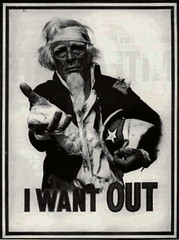 Today's NYTimes gives us a heads up on the expectant skyrage to come:
Today's NYTimes gives us a heads up on the expectant skyrage to come:"The airlines have come up with a new answer to an old question: How many passengers can be squeezed into economy class? A lot more, it turns out, especially if an idea still in the early stage should catch on: standing-room-only "seats."
Airbus has been quietly pitching the standing-room-only option to Asian carriers, though none have agreed to it yet. Passengers in the standing section would be propped against a padded backboard, held in place with a harness, according to experts who have seen a proposal..."
 That's right...it's Cornish pilchard time! But don't let this deter those of you with a fistful of cash, because, as you'd expect in the Dickensian world of Social Darwinism, them that's got shall get:
That's right...it's Cornish pilchard time! But don't let this deter those of you with a fistful of cash, because, as you'd expect in the Dickensian world of Social Darwinism, them that's got shall get:"Even as the airlines are slimming the seatbacks in coach, they are installing seats as thick and heavy as ever in first and business class — and going to great lengths to promote them. That is because each passenger in such a seat can generate several times the revenue of a coach traveler.And what's the likely upshot of all this? Envy, hate, anger, and boiling frustration, mixed with a healthy dollop of the kind of pain one experiences on an 8 hour intercontinental flight when one's limbs are pinned behind a seat like a dead butterfly's wings:
At the front of the cabin, the emphasis is on comfort and amenities like sophisticated entertainment systems. Some of the new seats even feature in-seat electronic massagers. And, of course, the airlines have installed lie-flat seats for their premium passengers on international routes."
"Here are some examples of "air rage."And this is nothing new. Reports of "air rage" were climbing through the mid-90's, according to one report from 1998, tied to the increased stress of tight quarters and reduced amenities for extended periods of time.
...was fined $50,000 by United Airlines after he assaulted an attendant and then defecated on a first-class food cart during a Buenos Aires-to-New York flight.
...removed his pants and then "simulated having sex with the back of his own seat."
...put his hands around the throat of a flight attendant and threatened her because she spilled a drink on him.
...grabbed a flight attendant by the arms and twisted her wrists. Levy was traveling with three children and explains that she lost her temper because her 20-month-old was crying, had wet pants, and there was no way to get to the bathroom."

"What's happening here? Chris Marquet, a New York-based senior managing director for corporate travel consultants Kroll Associates, believes cabin fever is the inevitable result of airline greed.In a 2000 health insurance magazine article lamenting the growing dangers from passengers faced by flight attendants, Kristin Kloberdanz writes:
"Space is tight. Planes are full," he explains. "When there are delays, when the flight's crowded, and you've got a lot of people in a small area, you've got the potential for some airline rage."

"Deregulation may well have contributed to the rise in in-flight abuse. Patricia Friend, the international president of the AFA, says that cramped planes and frustrating delays, together with airlines' liberal alcohol policies and a society-wide decline in civility, make an explosive combination. "The reality of the crowded airplane and the reductions of in-flight service's amenities offered is completely the opposite of the advertising the airlines do, in which they advertise this wonderful, marvelous experience. You fail to meet people's expectations."Even in good old laid-back Canada, an academic article from 2000 charted the rise of such incidents, with these explanations:
" 'Air rage' first manifested itself to flight attendants with the introduction of the Boeing-747 and the beginning of mass air travel inthe early 70's....Even Boeing knows how miserable the experience can be, judging by the list of horrors on their "Tips for the Traveler" page. The truth really comes home when you realize that the exercises they suggest to stave off muscle spasms and embolisms can be done by the intrepid whether in an airline seat or buried alive.
High-density aircraft seating configurations designed to maximize profitability create conditions enabling heightened passenger tension. The enclosed environment, the lack of humidity and fresh air, severely restricted passenger mobility; scarcity of food, drink and washrooms and the loss of personal control contribute to stress and social tension in the cabin environment. Being a well-adjusted passenger becomes a challenge, even to the most ingenious and experienced traveler."
 The last time I flew on a 8+ hour flight from NYC to London (on Virgin, Richard, and I did it as a favor to you because you overbooked the flight I'd been reserved on for 6 months), I was trapped at the back of the plane in the smallest space I can ever remember. It caused terrible, escalating pain from my shoulders down through my back into my legs---and for hours on end it only got worse, made even more insufferable by the seat-hopper who sat down next to me and pushed his way into my space as he snoozed. Maybe it wasn't Abu Ghraib, but I would have told them anything just to get an extra 5 inches on all sides. When that kind of nagging ache sinks into your bones, it's all you can think of. Every noise, every inadvertent invasion of "your" space, every bodily need not immediately assuaged becomes magnified, and irritation easily balloons into fury.
The last time I flew on a 8+ hour flight from NYC to London (on Virgin, Richard, and I did it as a favor to you because you overbooked the flight I'd been reserved on for 6 months), I was trapped at the back of the plane in the smallest space I can ever remember. It caused terrible, escalating pain from my shoulders down through my back into my legs---and for hours on end it only got worse, made even more insufferable by the seat-hopper who sat down next to me and pushed his way into my space as he snoozed. Maybe it wasn't Abu Ghraib, but I would have told them anything just to get an extra 5 inches on all sides. When that kind of nagging ache sinks into your bones, it's all you can think of. Every noise, every inadvertent invasion of "your" space, every bodily need not immediately assuaged becomes magnified, and irritation easily balloons into fury.What's amazing is how long these problems have been around, and how often they've been highlighted, yet no real solution has been offered other than the usual, after-the-fact punitive ones. A 1999 Salon article lists a depressingly long array of incidents, tells a tale of the "passenger from hell", and suggests that we know very little about the real problem:
"Because the FAA records only those incidents that airlines choose to disclose, the actual number of assaults is seriously underreported...United Airlines, to its credit, is one of the few U.S. carriers willing to disclose accurate information. In 1998, America's largest carrier reported 635 incidents of disruptive behavior by passengers. Of these, 61 were assaults.Boston psychologist Tom Cottle explained it this way:
In 1998, 84 U.S. carriers transported 614 million passengers on countless commercial flights. If a single airline (United) reported 635 incidents of disruptive behavior, and the FAA recorded only 283 incidents occurring on all 84 carriers -- well, passenger misconduct data collection methods are laughably incompetent.
David Fuscus, vice president of communications at the Air Transport Association, a trade organization representing U.S. airlines, believes there are at least 5,000 acts of passenger misconduct every year. The reasons, he claims, may be rooted in a stressful air-travel environment. "Planes are more crowded, passengers are less comfortable," he says."
"...air travel is a breeding ground for anxiety: fear of death, discomfort in crowds, separation from home and family, fouled-up sleep cycles. The 'mysterious sociology,' he said, also includes restrictions on where to stand or park your car, language that's used nowhere else ('your final destination'), class tensions evoked at the baggage counter: 'This line, which is very short, is for the first class, and this line is for the rest of you slobs.'"Recent incidents of air rage show that, while still under-reported, things continue to get worse. Last December some poor soul who hadn't gotten his meds started screaming nonsense, and was shot dead by air marshals. This year even swimsuit models are losing it.
And now we're being warned of that fashion forward bete noire, the sexual predator, prowling the friendly skies:
"According to research by federal prosecutors in Boston, sexual assault on airplanes is much more common than realized...
Of all crimes on airplanes investigated by the FBI in 2003, federal prosecutors said 12.5 percent involved allegations of sexual assaults. The number of sexual assaults on airplanes could be significantly higher in reality when considering the estimated number of reported cases is believed to represent just a percentage of actual events."
 God help us, people! The idea of hanging passengers like slabs of meat from inclined morgue tables is going to catch on here in the States faster than you can say soaring oil prices. The more of us that kill each other off in a stress-induced frenzy, the more room American and United will have for another row.
God help us, people! The idea of hanging passengers like slabs of meat from inclined morgue tables is going to catch on here in the States faster than you can say soaring oil prices. The more of us that kill each other off in a stress-induced frenzy, the more room American and United will have for another row.Maybe down in the cargo hold.





No comments:
Post a Comment